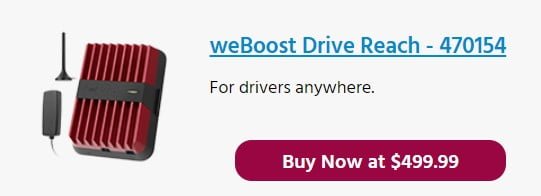- US Based Customer Support
- Free Shipping
- Up to 90 Day Money Back Guarantee
How do Signal Boosters Work?
HOW DOES A SIGNAL BOOSTER WORK?

Written by Sadia Jahangir
12th Nov 2022
What is a Signal Booster?
Over the past few years, the need for cell phone boosters has increased, shifting from rural to urban markets.
We occasionally receive inquiries about the functionality and legal standing of cell phone signal enhancers. The worry is entirely reasonable, especially in the case of a technology that appears to be too good to be true.
A cell signal booster is a piece of technology made to enhance current 5G, 4G, and LTE networks. They improve data speeds, signal strength, and call quality. Units that have been verified by the FCC and Industry Canada are entirely legal.
A cell booster can be useful if you have a usable signal outside your house, car, or place of business but little or no coverage inside. The same is true.
Many people are confused by the idea of enhancing phone reception and wonder how cell signal boosters function.
The solutions are here!
What Is the Process of Cell Phone Boosters?
The way a cell booster works is by bringing in your current outside signal, increasing it, and then rebroadcasting it into targeted regions. It is also known as a signal extender, signal amplifier, or cell phone repeater. The boosted signal is automatically picked up by cellular devices. Undeliverable texts, missed calls, and inaccurate data will be minimised or removed.
Boosters also function in reverse. The equipment detects outgoing signals from neighbouring cellular devices and relays them to your closest cell tower.
There are numerous sorts of boosters that cater to various needs:
- Designed for homes, workplaces, and commercial buildings, in-building signal boosters.
- Designed for cars, trucks, RVs, SUVs, yachts, and fleet vehicles, vehicle signal boosters.
A cellular amplifier needs a signal, however weak, outside of your house, place of business, or vehicle in order to function. Instead of producing new cellular signals, these devices improve the ones that already exist.
The following methods are used to improve in-building or in-vehicle cell coverage:
- An External Antenna
- An Amplifier
- An Indoor Antenna
- Coaxial Cable
For in-depth information on each element, keep reading.
What Is the Process of Cell Phone Boosters?
Home & Buildings
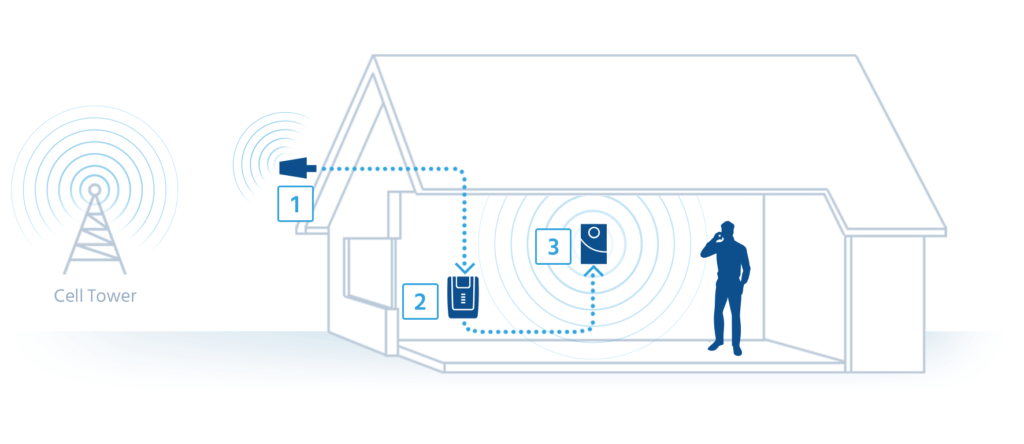

Cars & Vehicles
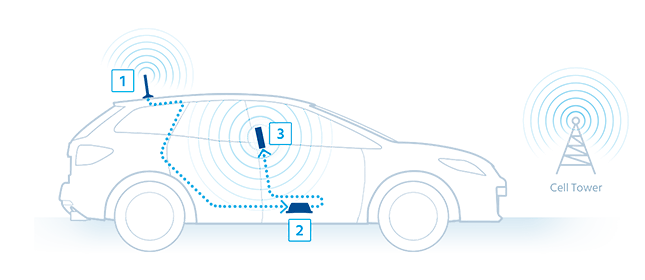

Commercial Buildings
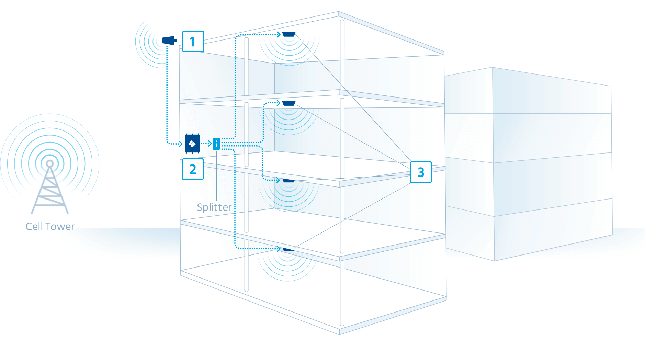
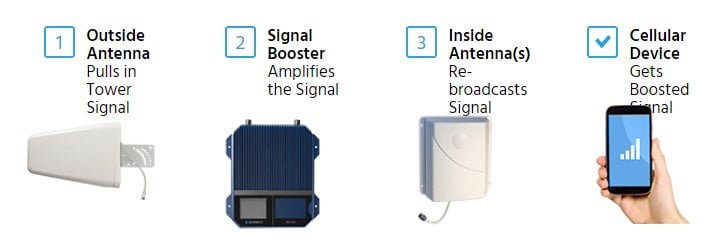
How Each Signal Booster Part Operates
External Antenna: Detects Existing Cell Phone Signal
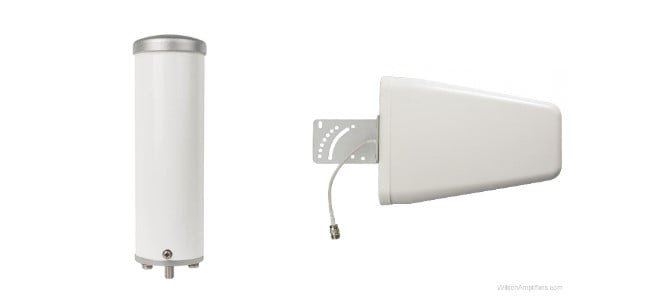
Donor antennas are external cellular antennas that collect compatible 5G/4G/LTE cellular frequencies from several providers. The amplifier receives the signal after it has been captured.
Outside antennas come in two varieties:
An antenna that receives signals in all directions is known as an omnidirectional antenna. It features an omnidirectional beam. They function optimally for
- offers a moderate to strong outside signal in homes and offices
- Multiple neighbouring cell towers for multiple carriers near homes and offices
- automobiles in motion
Uni-Directional Antenna: This antenna, which is formed like a triangle and is most frequently used, pulls signal from a single direction. Its beam is 45 degrees. The nearest tower is where they are supposed to point. The antenna may cover a wider area than an omni because of the more concentrated signal. a performer with unique skills for:
- a weak signal in homes and offices
- homes and offices that desire to increase the signal of just one carrier
- RVs that stay put
Donor antenna placement is essential. It may have an impact on how strong of a signal the amplifier gets. For best results, you should aim for the antenna to receive the strongest signal imaginable. As a result, we advise mounting them on the roof of your house, place of business, or car. The roof typically has the best signal because there are fewer barriers and better line-of-sight to surrounding towers there.
Increases Cell Signal Amplifier
The amplifier, as the name implies, receives the signal from the external antenna and magnifies it.
Only the gain value, expressed in dB, of the signal booster may increase cellular signal over that level (Decibels). The gain is essentially applied to the collected signal to increase the signal strength, which is expressed in dBm (decibel-milliwatts). Your signal is more dependable the closer you get to -50 dBm.
The precise amount of amplification you get will depend on how strong your signal is already. The booster will apply extra gain if the outside signal is weak. On the other hand, the booster will use less gain if the outside signal is strong. By doing so, overloading the device and interfering with surrounding cell towers are prevented.
A competent multi-carrier home amplifier should typically have a gain of at least +60 dB. The maximum gain for the most potent multi-carrier systems is +72 dB. The finest multi-carrier automobile amplifiers have a maximum output of +50 dB and should have at least +25 dB.
Indoor Antenna: Rebroadcasts Enhanced Signal Inside

The inner antenna or antennae receive the amplified signal and rebroadcast it to the targeted areas.
The following categories of indoor signal booster antennas exist:
Your level of coverage is heavily influenced by a number of variables, including:
Coverage will be drastically decreased if your signal is on the lesser end. Even with a strong outside signal, coverage will be reduced in buildings with closed floor designs. The broadcasted signal may not be able to reach all required corners due to walls and furnishings. Typically, panel antennas perform better in places with poor signal. Additionally, they perform better in signal transmission through barriers. It might be necessary to use many antennas to really maximize coverage.
-
- Panel Antenna (In-Building Use): This directional antenna is often installed on a wall. Its signal beam has a 45–70 degree angle. Prior to reaching lower priority regions, the strongest signal will be present in the vicinity.
-
- Dome Antenna (In-Building Use): This omnidirectional antenna is often positioned on the ceiling. It disperses the signal everywhere. They perform best in spacious, open spaces.
- Cradle Antenna: This directional antenna works best for a single user when used inside a vehicle. Any mobile device positioned on the cradle will receive the strengthened signal because it is connected to a small amplifier.
- Low-profile Antenna: The most widely used antenna for vehicle signal boosters is the low-profile antenna (in-vehicle use). Under ideal circumstances, it may cover the whole interior of a car because it is directed.
Your level of coverage is heavily influenced by a number of variables, including:
- Type of signal booster
- Types and counts of indoor antennas
- current signal intensity
- Building layout
Coverage will be drastically decreased if your signal is on the lesser end. Even with a strong outside signal, coverage will be reduced in buildings with closed floor designs. The broadcasted signal may not be able to reach all required corners due to walls and furnishings. Typically, panel antennas perform better in places with poor signal. Additionally, they perform better in signal transmission through barriers. It might be necessary to use many antennas to really maximize coverage.
Coaxial Cable: Relays Signal
All components are connected by the coaxial cable. It is responsible for transmitting the signal to the amplifier from the cellular antennas. They are made to transmit electrical signals at high frequencies with little signal loss.
Do Signal Boosters Really Work?
Many people doubt that signal boosters work. We cannot blame them because there are so many subpar items on the market. Our FCC-approved weBoost and Bftsync devices actually function. However, boosters can only strengthen already-present cellular signals. They are unable to generate cellular signals or increase WiFi on landlines (the U-verse, Time Warner kind).
Want proof? This graph displays the outcomes of a weBoost Home Complete installation at a house in a remote area of East Texas provided by Bftsync.
Signal Strength Before Installation | -116 dBm |
Signal Strength After Installation | -75 dBm |
The residence of one of our customers went from having poor cell service to having excellent reception. Click here to read the entire article.
What Signal boosters cannot do?
Outdoor use is not intended for cellular boosters.
Why can’t I place my signal booster outside is a common question we get from consumers. Are there exterior signal boosters, inquire others? Signal enhancers sadly only function in confined areas. This is so that the signal may “bounce” about, but there are no walls to “bounce” off of while it’s outside. A power source is also necessary for cell phone boosters. Although a battery backup might be able to alleviate that problem, the FCC forbids it, thus there isn’t much that can be done.
Carriers do not want signal boosters to re-deploy signal outside in addition to functioning less effectively. This should not be done because of the potential network-wide noise problems it could generate for nearby cell towers. The coverage for everyone can suffer if you reside in a rural location where a lot of people share the same tower.
At this point, it should be fairly clear that signal boosters do not produce new signal. Instead, they take what is already there, amplify it, and broadcast it again.
Home Signal Boosters that Really Work
Popular Midsize Home Signal Booster
- Complete coverage across all carriers for large households or many rooms with various devices that are 5G ready
- In ideal circumstances, coverage can reach 5,000 square feet.
- Gain of up to +65 dB, up to 21 dBm uplink, and down to 12 dBm downlink
- Configuration of an inside panel antenna and an outside Yagi antenna with elegant fabric front
- There are numerous attachments available for the greatest coverage and customization (sold separately)
The most well-liked signal booster of Bftsync is the weBoost Home Multiroom, and for good reason. It has a coverage range that typically suits the needs of most people and is priced, aesthetically pleasing, and efficiently at the sweet spot.
A panel antenna, a strong amplifier, and a Yagi antenna are all included in the kit. It can reach distant towers and cover many rooms or an entire house thanks to its high output capabilities and gain of up to 65 dB. Both city dwellers and residents of rural areas, where tower distance is a major issue, should consider it. It provides coverage of up to 5,000 square feet under ideal circumstances. The average size is between 2,000 and 3,000 square feet, though. Less can be expected in places with terrible cellular reception.
The weak signal situations should give this lower grade booster some thought. Consider the weBoost Home Complete for those exceptional circumstances and larger homes.
Professional Installed Signal Booster for Large Homes
- Superior home cell service for all carriers on a variety of devices – 5G capable
- Under ideal circumstances, coverage may reach 7,500 square feet.
- With up to 24 dBm uplink and 12 dBm downlink, the gain can reach up to +72 dB.
- Indoor panel antenna and outdoor Yagi antenna, both with fashionable fabric fronts
- There are numerous attachments available for the greatest coverage and customization (sold separately)
The most potent home booster available at Bftsync is the weBoost Installed Home Complete. Large homes with strong outside signals or mid-sized homes with weak outside signals can both receive whole-home coverage from it.
It has the highest maximum gain of any multi-carrier home device at +72 dB. It has slightly more than three times the power of the weBoost Home MultiRoom. This unit has greater reach and can provide excellent service indoors thanks to its strong uplink and downlink outputs. Most people receive between 4,000 and 6,000 square feet, while it can cover up to 7,500 square feet. For medium-sized to large households, that’s still more than enough. However, remote areas might anticipate a little less. Additional antennas are necessary to increase coverage, especially if you’re attempting to cover several floors.
The fact that it includes expert residential installation is its biggest feature. We also provide a Do-It-Yourself weBoost Home Complete if you’d prefer to install the booster yourself.
Best Signal Booster for One to Two Rooms
- Complete protection for carriers across numerous devices for one to two – 5G capable
- In ideal circumstances, coverage can reach 2,000 square feet.
- Gain of up to +60 dB, up to 23 dBm uplink, and down to 13 dBm downlink
- Configuration of an interior whip antenna with an outdoor Yagi antenna
- Design is small and fits on any flat surface.
The cheapest home signal booster is the weBoost Home Studio. Ideal for those on a tight budget who wish to boost their cellular reception in confined spaces.
A whip antenna-attached amplifier and a Yagi antenna for greater range are included in the kit. Its small size makes installation quick and simple. It can provide improved cell reception over 2,000 square feet in ideal circumstances. In reality, it usually offers enough coverage for either one large room or two smaller ones.
It’s a terrific kit for people who struggle to maintain a dependable connection in the rooms that matter despite having a strong outside signal. You won’t get the results you want if you reside in a weak signal location; instead, you might think about the weBoost Home MultiRoom.
Vehicle Signal Boosters That Actually Work
Most Common Vehicle Signal Booster for Multiple Users
- Enhances call, text, and data and is 5G ready.
- Numerous cellular devices across all providers are amplified
- Gain of up to +50 dB, up to 26.9 dBm uplink, and down to 4.8 dBm downlink
- Works in remote and extremely rural locations
- Extremely adaptable, having variations for any kind of vehicle and circumstance
The most potent multi-carrier vehicle cell signal repeater is the weBoost Drive Reach. For the majority of instances, it’s the booster we strongly advise.
The multi-carrier vehicle booster with the maximum uplink output power is this one. As a result, it can get a signal from cell towers that are two times as far away. It performs admirably on even the most remote roads and highways and is far more powerful than its rivals.
The signals are captured by a small magnet mount exterior antenna, and the signal is disseminated inside your car via a low-profile inside antenna. Every type of vehicle has a Drive Reach variant. It works well with cars, SUVs, RVs, yachts, and semis.
Best Value Vehicle Signal Booster
- Enhances call, text, and data and is 5G ready.
- For just one gadget
- Utilises all carriers
- Gain of up to +23 dB
- Signal booster cradle
The most affordable vehicle cellular amplifier for a single device is the weBoost Drive Sleek.
The kit comes with a magnet mount antenna and a flexible vent mount that can accommodate any size smartphone. Your mobile device needs to be nested in the cradle in order to receive amplified signal. It really shines for normal conversation, text, and hands-free navigation when linked with a Bluetooth headset.
In locations with poor signal, it doesn’t operate as well as it could. Think about using the weBoost Drive Reach in those circumstances. Choose the weBoost Drive Sleek OTR if you need a signal user signal booster for semis.
Powerful Signal Boosters for RVs, Trailers, and Campers
- Enhances call, text, and data and is 5G ready.
- Numerous cellular devices across all providers are amplified
- With up to 24.8 dBm uplink and 2.8 dBm downlink, there is a gain of up to 50 dB.
- Works in locations with weak and strong signals
- Extremely adaptable, having variations for any kind of vehicle and circumstance
For RVs, trailers, and campers, the weBoost Drive X RV is a fantastic multi-user vehicle booster. It only needs one simple installation and may be utilized both while moving and still.
For better coverage while moving, this kit contains top-of-the-line interior and outdoor OTR (over-the-road) antennas. The Drive X RV can typically transmit a dependable signal up to 10 feet from the interior antenna. Perfect for Class B vehicles because it should take up the majority of the inside area. However, Class A and Class C RVs can also use it. You can also choose to install other Drive X iterations in a car, truck, SUV, or boat.
Think about the weBoost Destination RV if you park your vehicle most of the time. Since it’s primarily intended for stationary use, it’s far more powerful than the Drive X.
How Can We Help You?
The top supplier of cellular amplifiers with FCC certification is Bftsync. All North American carriers and devices are compatible with our home, office, automotive, and corporate units. Also, they are 5G ready. After installation, your house, place of business, or vehicle won’t have poor cell service or slow data again.
Now that you are aware of how and why signal boosters function, we can assist you in selecting the best one for your needs. For a free consultation, contact us by phone at (+1 281 616 5786), email at (mail@bftsync.com), or live chat. Ask us anything; we’re more than happy to assist!








